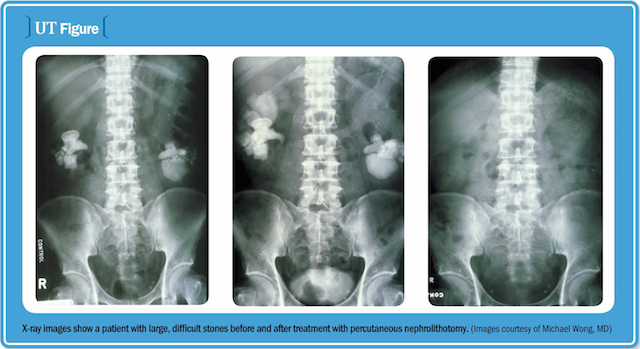Article
Difficult stones present treatment, training challenges
Author(s):
In this interview, Dr. Wong describes difficult stones, discusses the skills and training required to treat them, and outlines the role of different treatment modalities.

Michael Wong, MDThe difficult stone case presents a challenge to the clinician-a challenge that requires considerable knowledge and experience to tackle, according to Michael Wong, MD, medical director and senior consultant of the Urology, Fertility, and Gynecology Center at the Mount Elizabeth Hospital in Singapore. In this interview, Dr. Wong describes difficult stones, discusses the skills and training required to treat them, and outlines the role of different treatment modalities. Dr. Wong was interviewed by Urology Times Editorial Consultant Stephen Y. Nakada, MD, the Uehling Professor and founding chairman of the department of urology at the University of Wisconsin, Madison.
Please briefly discuss your background in urology and stone disease.
My interest in urology and stone disease in particular started when I experienced my first ureteric colic 25 years ago. At that point in time, I was in a hepatobiliary residency. After the passage of stones, I decided I should do urology. I had the privilege of being Dr. Jim Lingeman’s fellow in 1994. After this fellowship, I returned to Singapore and have spent 22 years in an academic institution and 8 years in a private institution.
What is a difficult stone?
The biggest category of difficult stones in our practice consists of high-volume staghorn stones. We see a lot more staghorn stones in Asia than in most parts of the world. The other category of difficult stones consists of those that reside in abnormal kidneys, such as pelvic stones.
Who do you think should be treating the difficult stone?
It should be someone who has a subspecialty interest and who is trained in this area, so an endourology fellow would probably be the best person to handle these kinds of stones.
Next: What type of experience would a typical endourology fellow have to make them suitable for these kinds of surgeries?
What type of experience would a typical endourology fellow have to make them suitable for these kinds of surgeries?
They should have undergone a structured training program, and they should have the correct mindset in terms of decision making. In addition, they should have sufficient clinical training and exposure and should be mentored by someone very senior to ensure that they are in the best position to treat these stones.
Difficult stones are treated primarily by percutaneous stone removal and ureteroscopy. What skills are required for percutaneous stone removal compared to ureteroscopy?
The training for percutaneous removal is probably not as adequate as it is for ureteroscopy. A lot of Asian hospitals in particular, after they obtain basic equipment and skill training in lower tract endourology, tend to jump into the laparoscopic and robotic setting rather than move up to upper tract endourology training. I think one of the key technical points in training that’s essential to a successful outcome in percutaneous removal is the ability to obtain accurate and safe renal access. That’s very important.
Can you elaborate on what ureteroscopy skills are essential? What sorts of things should you be able to do at the higher level?
You should be able to switch from a semi-rigid to a flexible instrument. You should be able to manipulate the instrument in the collecting system. And of course, you should be able to treat bigger and bigger stones and more challenging pathology as you gain more skill and more experience in this area.
Next: Do you think access to equipment is a key factor?
Do you think access to equipment is a key factor?
In Asia, most hospitals only offer semi-rigid ureteroscopy, so one of the things that we’re trying to do, especially at the Asian School of Urology, is to run as many workshops as we can to teach physicians how to handle flexible ureteroscopy. It’s very different from handling laparoscopic equipment. That’s something we’re working very hard on.

Tell us more about these workshops and how they may be bridging the gap in education.
First, we have to have industry support. Olympus works with the Asian School of Urology often. We hold 2- to 3-day workshops across Asia. The first day consists of didactic lectures and dry labs. On the second day, there are live operating demonstrations and sometimes mentoring from senior members of the community in which the workshops are held. These workshops are essential to introduce the skills, equipment, and technology that are probably missing from many parts of Asia.
You alluded to the fact that your training in the United States was very important. Please discuss some of the key aspects of that training, particularly as it relates to percutaneous stone removal.
When you work with some of the best endourologists in the world, you find that you can learn a lot more fine points in technique. I learned a lot before I came to the United States, but I can tell you I learned even more when I left after spending 2 years there. There’s always more to learn, and there are always more skills to pick up.
Next: Roles of mini-, micro-PCNL
Where do mini- and micro-percutaneous nephrolithotomy fit in the treatment of difficult stones?
In Asia, most of the stones are quite sizable in terms of volume, so I think standard PCNL is still the way to go. Mini- and ultra-mini-perc are being performed only in very selected small-size stones. There are many challenges as you decrease the size, such as the caliber of the percutaneous tract with instrumentation.
What particular difficult stones would you treat using mini perc?
If a stone is also suitable for flexible ureteroscopy-a small-size stone between 1 and 2 cm-and for one reason or another you’re not performing retrograde manipulation, some centers have decided to switch to mini perc. Equipment bias may play a role; flexible ureteroscopy equipment is very expensive; the instruments tend to break down, while a semi-rigid scope tends not to break down.
Please discuss the benefits and drawbacks of tubeless PCNL.
In general, tubeless PCNL is a consideration in an uncomplicated procedure. The benefit is patient comfort and less pain meds. The potential downside is loss of percutaneous renal access if the need for a secondary procedure arises later.
Next: "The key to shock wave lithotripsy is to recognize its limitations."
What do you think the role is for shock wave lithotripsy in treating the difficult stone?
The key to shock wave lithotripsy is to recognize its limitations. Case selection is extremely important. The most important factors are a low stone burden and a softer stone. To be honest, shock wave is limited in many ways, and we should be careful not to treat too many high-volume stones with it.
Do you think there are any high-volume stones we should treat with shock wave?
For any stone larger than 2x2 cm, I would really scratch my head as to whether we should be treating that stone with shock wave.
How would urologists go about getting training in obtaining percutaneous access if they haven’t done a fellowship?
A majority of urologists are migrating to a central teaching institution within their country. There are many good teaching institutions all over Asia. If Asian urologists cannot go to the U.S. or to Europe to train, they can migrate to one of these Asian centers, where the volume is high and the mentors are good. That’s the way forward today.
So you essentially think that urologists wanting to learn percutaneous access should do a fellowship?
I think they should either have a mentor who can teach them very well or they should participate in a full structured fellowship program.
Next: Laparoscopy, robotics
How do you see the role for laparoscopy and robotics in difficult stones?
Currently, it’s still very limited. Laparoscopy may have a role, especially in malformed kidneys and pelvic kidneys or where the abnormalities are quite significant. Laparoscopy could also have a place for a transabdominal approach in select cases.
What advice would you give to a urologist faced with a difficult stone?
They need to ask themselves two questions: Why am I treating this stone, and am I the best person to treat it? It’s always good to get experienced colleagues to come in if they are available and if not, to refer the patient to experienced colleagues to handle these difficult stones and ensure that the patient outcome will be optimal.
More on Stone Disease
Smoking associated with greater risk of urolithiasis
Urolithiasis: Genetics and lifestyle rule
What drives unplanned returns post-URS lithotripsy?
Subscribe to Urology Times to get monthly news from the leading news source for urologists.

















